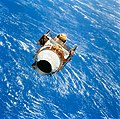STS-51
| Missionsemblem | |||||
|---|---|---|---|---|---|
 | |||||
| Missionsstatistik | |||||
| Missionsnavn: | STS-51 | ||||
| Rumagentur: | NASA | ||||
| Rumfærge: | Discovery (17) | ||||
| Antal besætningsmedlemmer: | 5 | ||||
| Affyringsrampe: | LC-39B (KSC) | ||||
| Opsendelse: | 12. september 1993 | ||||
| Landing: | 22. september 1993 | ||||
| Landet på: | Kennedy Space Center | ||||
| Varighed: | 9 døgn og 20 timer | ||||
| Foto af besætningen | |||||
 | |||||
| Navigation | |||||
| |||||
STS-51 (Space Transportation System-51) var rumfærgen Discovery 17. rumfærge-mission. Den blev opsendt d. 12. september 1993 og vendte tilbage den 22. september 1993.
Missionen primære nyttelast var satelliterne Advanced Communications Technology Satellite (ACTS) og Orbiting and Retrievable Far and Extreme Ultraviolet Spectrograph-Shuttle Pallet Satellite (OERFEUS-SPAS).
Hovedartikler:
Besætning

 Frank Culbertson (kaptajn)
Frank Culbertson (kaptajn)
 William Readdy (pilot)
William Readdy (pilot)
 James Newman (1. missionsspecialist)
James Newman (1. missionsspecialist)
 Daniel Bursch (2. missionsspecialist)
Daniel Bursch (2. missionsspecialist)
 Carl Walz (3. missionsspecialist)
Carl Walz (3. missionsspecialist)
Missionen
Missionen medbragte følgende nyttelast:
- Advanced Communications Technology Satellite (ACTS)
- Orbiting and Retrievable Far and Extreme Ultraviolet Spectrograph-Shuttle Pallet Satellite (OERFEUS-SPAS)
- Limited Duration Space Environment Candidate Material Exposure (LDCE)
- IMAX 70 mm camera
- Commercial Protein Crystal Growth (CPCG) Block II
- Chromosome and Plant Cell Division in Space (CHROMEX-04)
- High Resolution Shuttle Glow Spectroscopy (HRSGS-A)
- Aurora Photography Experiment (APE- B)
- Investigation into Polymer Membranes Processing (IPMP)
- Radiation Monitoring Equipment III (RME III)
- Air Force Maui Optical Site (AMOS) calibration test
Discovery set med IMAX fra ORFEUS SPAS
Eksterne henvisninger
- STS-51 NASA (engelsk)
- STS-51 Arkiveret 2. marts 2009 hos Wayback Machine NASA KSC (engelsk)
| ||||||||
Medier brugt på denne side
The space shuttle orbiter Discovery seen from the IMAX camera aboard the SPAS-ORFEUS satellite during mission STS-51 in September 1993.
The STS-51 crew portrait features (left to right): Frank L. Culbertson, commander; Daniel W. Bursch, mission specialist; Carl E. Walz, mission specialist; William F. Readdy, pilot; and James H. Newman, mission specialist. The crew of five launched aboard the Space Shuttle Discovery on September 12, 1993 at 7:45:00 am (EDT). Two primary payloads included the Advanced Communications Technology Satellite (ACTS), and the Orbiting and Retrievable Far and Extreme Ultraviolet Spectrograph Shuttle Pallet Satellite (OERFEUS-SPAS).
STS-57 Endeavour, Orbiter Vehicle (OV) 105, crew insignia (logo), the Official insignia of the NASA STS-57 mission, depicts the Space Shuttle Endeavour maneuvering to retrieve the European Retrievable Carrier (EURECA) microgravity experiment satellite. Spacehab -- the first commercial space laboratory -- is depicted in the cargo bay (payload bay (PLB)), and its characteristic shape is represented by the inner red border of the patch. The three gold plumes surrounded the five stars trailing EURECA are suggestive of the United States (U.S.) astronaut logo. The five gold stars together with the shape of the orbiter's mechanical arm form the mission's numerical designation. The six stars on the American flag represent the U.S. astronauts who comprise the crew. With detailed input from the crewmembers, the final artwork was accomplished by artist Tim Hall. The names of the STS-57 flight crewmembers are located along the border of the patch. They are Commander Ronald J. Grabe, Pilot Brian J.
Mission Specialist James H. Newman conducts an in-space evaluation of the Portable Foot Restraint (PFR) which will be used operationally on the first Hubble Space Telescope (HST) servicing mission and future Shuttle missions. He is positioned on the edge of Discovery's payload bay. Behind him the starboard Orbital Maneuvering System (OMS) pod can be seen with the soft glow of an Earth limb.
The Advanced Communications technology Satellite (ACTS) moves away from the space shuttle Discovery after deployment on mission STS-51.
STS-58 Crew Insignia
Forfatter/Opretter: Kwamikagami, Licens: CC BY-SA 4.0
symbol of Mars. 16 × 16 pixel nominal dimensions, lines 2 pixel thick, square caps. Colour 75% blue: red=0 green=0 blue=191 (#0000BF).
STS-51 Patch
Rotated and color enhanced version of original (ISS013-E-48788 (6 July 2006) --- The Space Shuttle Discovery approaches the International Space Station for docking but before the link-up occurred, the orbiter "posed" for a thorough series of inspection photos. Leonardo Multipurpose Logistics Module can be seen in the shuttle's cargo bay. Discovery docked at the station's Pressurized Mating Adapter 2 at 9:52 a.m. CDT, July 6, 2006.)
The ORFEUS\SPAS platform is captured by the RMS on STS-51.















